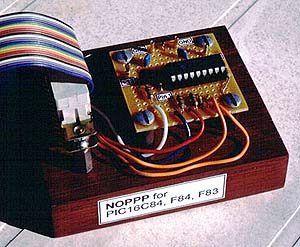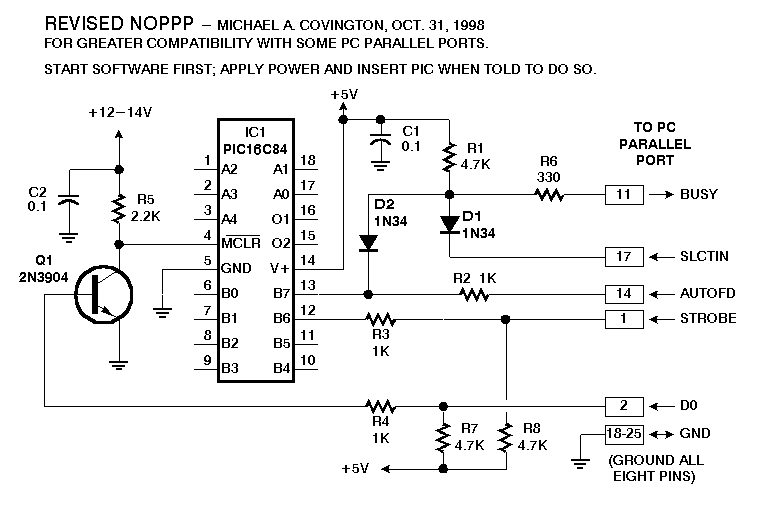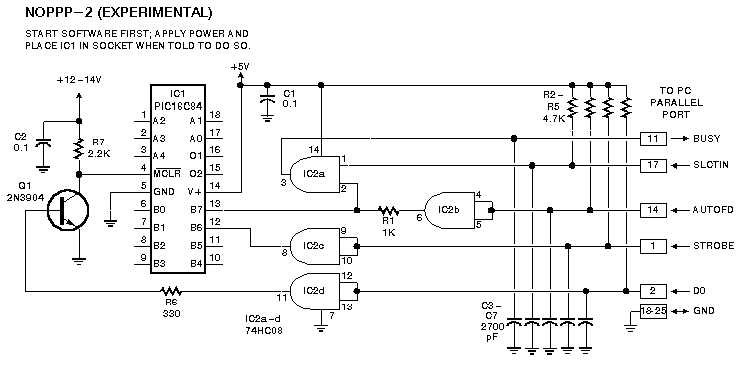793 Canning Parkway
Victor, NY 14564
Phone 800-446-2295
It's called "Picpro," Part No. PIC-1, and sells for $59.95 + $6.95 shipping/insurance (in the U.S.A.; slightly more overseas). Credit cards are accepted.
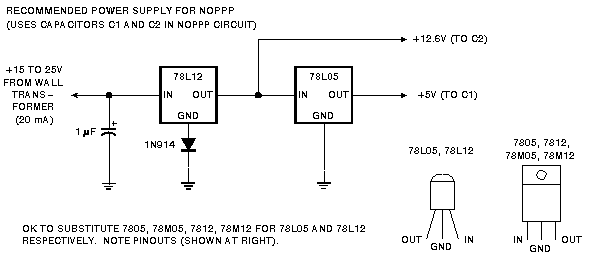 The extra diode raises the output voltage of the 78L12 by 0.6 volt, ensuring that it is within the 12.0-to-14.0-volt range specified for the PIC.
The extra diode raises the output voltage of the 78L12 by 0.6 volt, ensuring that it is within the 12.0-to-14.0-volt range specified for the PIC. The last 2 of these have a particularly interesting selection of resources for experimenters and hobbyists.
- "Caution: programmer hardware not found!" The NOPPP software is unable to detect the NOPPP hardware. With the original circuit, this is not necessarily a problem; the original circuit will sometimes not be detected if powered off. In that case, power up the NOPPP hardware (without a PIC in the socket, of course) before starting the software on your PC.
- "Caution: Configuration word appears to contain invalid bits." Your .HEX file was assembled for a different PIC (such as 16F84 rather than 16C84). It may not work if programmed into the PIC that you have currently selected. Note that DEMO.HEX, provided with NOPPP, was assembled for the 16F84. To change it, go into DEMO.ASM, change both references to "16F84" to "16C84", and reassemble it (generating a new .HEX file) using MPASM or MPLAB. Reportedly, however, it works on the 16C84 without modification, despite error messages.
- "Failed at 0000: Expecting (something), found 3FFF." You are trying to verify a blank PIC without having programmed it, or... This is a common symptom of a data communication problem; it indicates that the PIC is not receiving commands correctly. Try a shorter cable; check the circuit carefully; run the voltage checks. Also make sure that your .HEX file was generated for the right kind of PIC (16F84 or 16F84A; they are not the same). The options when running the assembler, the directives in the PIC program itself, the choices you make when running NOPPP, and the actual processor that you are using must all agree. (Thanks to Evan Robinson for this tip.)
- Are all connections correct and properly soldered? (Check with an ohmmeter, or better yet, run the voltage checks in the test mode of the latest NOPPP software.)
- Is the transistor (Q1) connected correctly? If some of its connections are swapped you will probably get voltages around 8 V during some of the voltage checks. Replace the transistor if it has been connected incorrectly; even if it seems to work afterward, its life has probably been shortened. Here's the pinout:
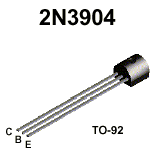 Cheap assorted transistors often do not have the pins in the specified arrangement; all the transistors in an assortment will not necessarily be the same. Only transistors with type numbers printed on them are trustworthy.
Cheap assorted transistors often do not have the pins in the specified arrangement; all the transistors in an assortment will not necessarily be the same. Only transistors with type numbers printed on them are trustworthy.
- Are all 8 of the ground wires from the parallel port all tied to circuit ground on the NOPPP circuit board? If not, there will be excessive crosstalk in the cable; the multiple ground wires serve as shields.
- Are you using a fresh or tested PIC and protecting it from static electricity?
- Are your power supply voltages within specified limits (4.75-5.25 and 12.0-14.0 volts respectively)?
- Have you tried different BIOS settings for the parallel port that you are using? NOPPP should work with any settings, but in difficult cases it's good to try alternatives.
- Are cable pin numbers correct? Note that the pin numbers in the diagram pertain to the 25-pin connector on the PC, not a 36-pin Centronics connector. Make sure that all connections are wired straight through.
- Does the cable from your computer to NOPPP actually connect all the lines that are used? Serial-port cables do not! Also, my own experience is that cables that make bad connections are extremely common. A cable can test out fine with an ohmmeter and still fail to make good connections to some sockets due to slight variation in the length of the pins.
- Is your cable too long? Try NOPPP with the shortest cable possible (under 2 feet). Some parallel ports work fine driving NOPPP through much longer cables; some don't.
- Is the 0.1-microfarad capacitor connected across +5V and ground as close to the PIC as possible?
- Are you using some other kind of programmer to verify a PIC that was programmed by NOPPP? Note that NOPPP sets undefined locations to 0000; other programmers set them to 3FFF.
- Finally, does your parallel port work? Can you use it to connect your computer to a printer? Some people have had trouble with NOPPP only to discover they were using a dead parallel port (parallel output had been redirected to a network).
